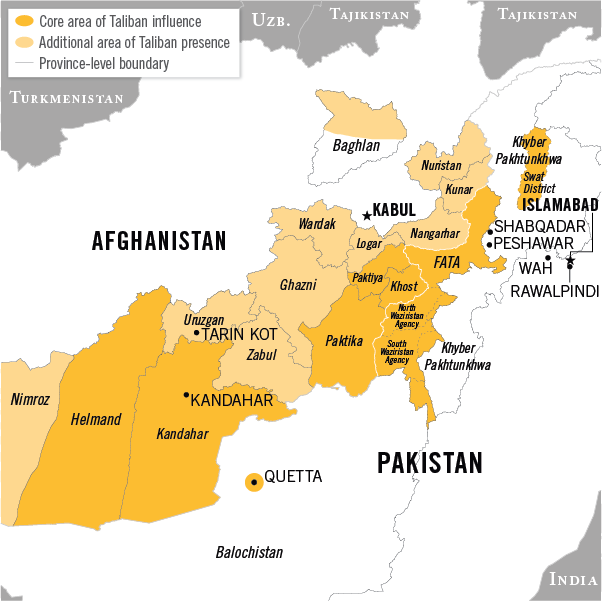Taliban – Pakistan War Explain | India’s Role
On the border, the Pakistani army and the Taliban were at war. Pakistan attacked Afghanistan from the air last week. The Taliban then attacked within a week. Tehreek-e-Taliban, a militant organization based in Pakistan, attacked and killed 16 troops.

Beyond from inconsistent strikes, estimates suggest that approximately 15,000 Taliban soldiers are gathering near the Pakistani border, indicating a potential large-scale invasion.
History Behind the War
The Durand Line, a colonial-era line that divided territories and communities between Afghanistan and what is now Pakistan, was never formally accepted by any Afghan state following Pakistan’s formation in 1947. The Durand Line has become recognised as the two countries’ boundary, and Pakistan has almost completely walled it. However, because it separates Pashtuns on both sides of the border, the Durand Line has become an issue of dispute in Afghanistan.
The Durand Line was not supported by the Taliban government in the 1990s, and the present Taliban leadership is doing the same. This is viewed as an annoyance in Pakistan and a challenge to the idea of Pakistan’s “strategic depth” in Afghanistan.
The scene of armed insurrection appears to have moved to Pakistan as a result of the Taliban’s victory in Afghanistan. Since 2022, there has been a notable increase in militant assaults against Pakistani security and police forces, especially in the areas of Khyber Pakhtunkhwa and Balochistan.
The so-called Pakistan Taliban, Tehreek-e-Taliban Pakistan (TTP), is responsible for the majority of the attacks. For years, the TTP and Afghan Taliban have symbiotic relationships, sharing refuge, tactics, and resources, often in Waziristan and other Pakistani territories bordering Afghanistan.
After 2001, Pakistan treated the Afghan Taliban as ‘friends’, intending to reduce any feeling of cross-border Pashtun nationalism while also using its influence on the Taliban in Afghan developments and ties with the US. The US military chief at the time, In 2011, Michael Mullen, the US military chief at the time, claimed that the Haqqani Network, a significant component of the Afghan Taliban, was a “veritable arm” of Pakistan’s intelligence agency, the Inter-Services Intelligence Agency (ISI). Analysts projected, as was feared, that Pakistan’s backing for the Taliban’s takeover of Afghanistan would result in a ‘Pyrrhic victory,’ with Pakistani fighting groups and other violent nonstate actors feeling strengthened rather than weakened.

INDIA’S ROLE IN AFGHANISTAN
when disputes appear between India and its neighbours, including China, Bangladesh, Sri Lanka, and Pakistan. India is expanding its influence in Afghanistan and applying strategic pressure there.
Thus, in the 1990s, India, Russia, and Iran were able to find common ground. They all believed that the US was an unwanted force in the area. Cold War rivalry defined Russia’s relationship with the US. The United States’ support of Pakistan was a major source of concern for India. Additionally, for political and religious reasons, postrevolutionary Iran’s relations with the West were severely strained.
The Taliban were seen as a threat to the internal security of all three nations. A Sunni government supported by Saudi Arabia on Iran’s eastern border was unacceptable.
Moscow was worried that Islamist movements in Chechnya may be strengthened if the Taliban, with al-Qaeda’s help, consolidated their hold on power in Afghanistan.
India believed that the Taliban were an organisation supported by Pakistan that might make the current insurgency worse.
India has implemented many projects and programs in Afghanistan, including:
Infrastructure –
The Afghan Parliament, the Zaranj-Delaram highway, the Salma Dam, and a hospital in Kabul are just a few of the infrastructural projects that India has constructed in Afghanistan. India also constructed transmission cables and public restrooms.
Providing humanitarian relief
India has sent food, medication, and vaccines to Afghanistan as humanitarian help. For instance, in January 2022, India shipped 500,000 doses of the COVID vaccine to Afghanistan.
Education
Afghan professionals and students have received training and scholarships from India. For instance, Afghan students can study in India on scholarships provided by the Indian Council for Cultural Relations (ICCR).
Trade
In 2003, a preferential trade agreement was signed between Afghanistan and India.
Community development
India has undertaken community development projects in fields such as education, health, agriculture, and renewable energy.
India’s active involvement in Afghanistan highlights its commitment to fostering regional stability and cooperation amidst evolving geopolitical challenges.
India – Afghanistan Relation (Source from – Embassies of India)




